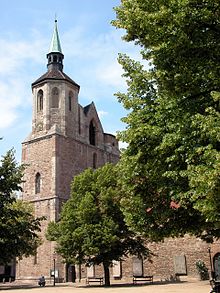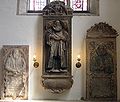St. Magni (Braunschweig)
The Magnikirche in Braunschweig dates from the early 11th century and today forms the center of the Magniviertel in the old Weichbild Altewiek .
history
The certificate of consecration from 1031 is the first documentary evidence of the existence of what the city of Braunschweig is today. In the document, the settlement is called Brunesguik . The Apulian bishop Magnus , who was especially venerated by the Frisians , is believed to be the patron saint . In this case, the settlement would have had trade relations with the North Sea very early on .
Deed of consecration from 1031
The certificate of consecration from 1031 is made in the form of a protocol or a "notitia". Brunesguik ( Braunschweig or Altewiek ), Everikesbutli (desert, in the Querum area ), Thuringesbutli (desert, Schunteraue ), Ibanroth ( Bienrode ), Velittunun ( Veltenhof ), Hanroth (desert, belonging to Veltenhof), Guinitthun ( Wenden ), Riudun ( Rühme ), Marquarderoth (desert, Nordstadt ), Ottonroth (desert, am Nußberg ), Glismoderoth ( Gliesmarode ) Huneshem (desert, am Lünischteich , Riddagshausen ), Fritherikesroth (desert, between Mastbruch and Mittelriede ), Ruotnun ( Rautheim ), Morthorp (wüst, on the Braunschweig main cemetery on the Streitberg, see Viewegs Garten-Bebelhof ), Reindageroth (wüst, near Rautheim), Limbeki (wüst, Bebelhof , see Viewegs Garten-Bebelhof) and Ekthi (wüst, on the Zuckerberg see Viewegs Garten -Bebelhof). All these places are or were located east of the Oker, which belonged to the Halberstadt diocese until the Reformation . The places on the western side of the Oker belonged to the diocese of Hildesheim .
Building history

The parish church of St. Magni was rebuilt from 1252, remnants of the original church have been preserved in the foundations. In the bell house between two short octagonal towers on the cube-shaped Saxon west bar hangs the "Magnus bell" from 1335, the oldest bell in the Braunschweiger Land. The Magni Church has a total of five bells, of which the two smallest are not used to ring.
- Army or peace bell, cast year 1643, approx. 3000 kg, tone h.
- Magnus bell, casting year 1335, approx. 2000 kg, tone d ′.
- Hour bell, cast year 1406, approx. 1000 kg, tone f sharp ′.
- Bell, cast year 1630, 58 kg, sound f sharp ′ ′.
- Schandel bell, cast in 1445, 23 kg, tone f sharp ′ ′ ′.
Between 1873 and 1877 the building was restored by Ludwig Winter and painted in the historicist style by Max Osterloh and Adolf Quensen . Glass windows were created by Otto Linnemann from Frankfurt am Main in 1926 . During the Second World War , the church was very badly damaged, especially by the bombing raid on April 23, 1944. After the end of the war, only the tower and the arcade of columns of the nave remained . From 1956 to 1964 the building was restored in a significantly modified, partly modern form.
In 1958, a modern sculpture called Der Rufer by Bodo Kampmann was attached to the gable of the choir, looking from the gable wall onto the lower central part of the nave . It symbolizes the apocalyptic angel who blows the trumpet on the Last Judgment . The angel's admonishing call was related to the Second World War and the destruction of Braunschweig.
The train of the Israelites through the Red Sea can be seen in modern stained glass on the north wall of the nave. In the church there is a bronze baptismal font from 1468, remains of a Passion cycle , several epitaphs and the torso of the baroque high altar from 1730/1734, begun by Anton Detlev Jenner and completed by Matthäus Heinrich Vetten . For the re-consecration in 1964, the church received a modern crucifix by Ulrich Henn . The organ comes from the Alfred Führer company .
During the reconstruction, the nave was made in a significantly lower shape, the remains of the windows on the south wall were bricked up and the north side was made of concrete with long windows. The completely destroyed apse from 1447 was rebuilt without Gothic tracery in the windows, the intact northern columned arcade of the nave was removed in favor of a large hall-like church space. The vault was also only restored above the apse; a roof with wooden cladding was installed inside the nave , which rests on the preserved columned arcades on the southern side and is supported by a concrete structure on the northern side.
The reconstruction of Braunschweig's oldest church in a modern form has been criticized many times. On the one hand, intact historical substance had been removed, on the other hand, what had been completely destroyed (the apse) was rebuilt in a simplified, historicizing form that never existed. Above all, the Magnikirche would not have had a yoke gable before its destruction, which is otherwise common for the Brunswick churches. After the reconstruction, the yokes of the apse were still provided with gables.
gallery
literature
- Elmar Arnhold: St. Magni - Parish Church of the Altewiek. In: Medieval metropolis Braunschweig. Architecture and urban architecture from the 11th to 15th centuries. Appelhans Verlag, Braunschweig 2018, ISBN 978-3-944939-36-0 , pp. 134-138.
- Ernst Brutzer: St. Magni. Memorial book 1931. Wollermann & Bodenstab, Braunschweig 1931.
- Reinhard Dorn : Medieval churches in Braunschweig. Niemeyer, Hameln 1978, ISBN 3-87585-043-2 , pp. 228-229.
- Hermann Dürre : History of the City of Braunschweig in the Middle Ages. Braunschweig 1861, pp. 477 - 483. (digitized version )
- Bernd Jericho: St. Magni. In: Luitgard Camerer , Manfred Garzmann , Wolf-Dieter Schuegraf (eds.): Braunschweiger Stadtlexikon . Joh. Heinr. Meyer Verlag, Braunschweig 1992, ISBN 3-926701-14-5 , p. 150-151 .
- Wolfgang Kimpflinger: Monuments in Lower Saxony. Volume 1.1 .: City of Braunschweig. Part 1 (= monument topography Federal Republic of Germany ). Hameln 1993, ISBN 3-87585-252-4 , pp. 144-145.
- Church council of St. Magni Braunschweig (ed.): Pictures and texts on the history of the St. Magni Church in Braunschweig. Braunschweig 1981.
- Paul Jonas Meier , Karl Steinacker : The architectural and art monuments of the city of Braunschweig. 2nd, expanded edition. Braunschweig 1926, pp. 30-33.
Web links
- Homepage of the St. Magni parish
- Portal to the Magniviertel
- The bells of St. Magni (PDF file 1.56 MB)
Individual evidence
- ↑ Audio file of the full bells of the Magni Church ( page no longer available , search in web archives ) Info: The link was automatically marked as defective. Please check the link according to the instructions and then remove this notice. ( Plenary )
Coordinates: 52 ° 15 ′ 44 ″ N , 10 ° 31 ′ 49 ″ E

















